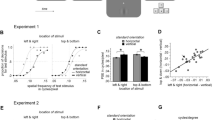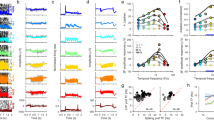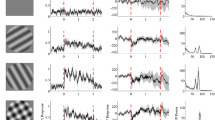Summary
Human occipital potentials evoked by stimulation with a counterphase flickering grating were recorded by a digital narrowband filter technique. The data showed a surprising degree of narrow tuning to particular spatial frequencies in addition to the expected narrow temporal frequency tuning. At each temporal frequency, there could be two or more peaks of response to different spatial frequencies, each distinct from the whole field flicker response. Variations in this multiple spatial frequency tuning were investigated as a function of luminance, electrode location, and temporal frequency for several observers. The results are interpreted in terms of many stimulus-specific resonant neural circuits within the brain, and suggest that it is possible to make a highly detailed exploration of the responses of neural circuits to visual stimulation.
Similar content being viewed by others
References
Armington, J.C., Corwin, T.R., Marsetta, R.: Simultaneously recorded retinal and cortical responses to patterned stimuli. J Opt Soc Am 61, 1514–1521 (1971)
Blakemore, C., Campbell, F.W.: On the existence of neurones in the human visual system selectively sensitive to the orientation and size of retinal images. Physiol (Lond) 203, 237–260 (1969)
Campbell, F.W., Cooper, G.F., Enroth-Cugell, C.: The spatial selectivity of the visual cells of the cat. J Physiol (Lond) 203, 223–235 (1969)
Campbell, F.W., Green, D.G.: Optical and retinal factors affecting visual resolution. J Physiol (Lond) 181, 576–593 (1965)
Campbell, F.W., Maffei, L.: Electrophysiological evidence for the existence of orientation and size detectors in the human visual system. J Physiol (Lond) 207, 635–652 (1970)
Cobb, W.A., Morton, H.B., Ettlinger, G.: Cerebral potentials evoked by pattern reversal and their suppression in visual rivalry. Nature 216, 1123–1125 (1967)
Freeman, R.D., Thibos, L.N.: Visual evoked responses in humans with abnormal visual experience. J Physiol (Lond) 247, 711–724 (1975)
Fricker, S.J.: Narrow-band filter techniques for the detection and measurement of evoked responses. Electroencephalogr Clin Neurophysiol 14, 411–413 (1962)
Harter, M.R., White, C.T.: Evoked cortical responses to checkerboard patterns: Effect of check-size as a function of visual acuity. Electroencephalogr Clin Neurophysiol 28, 48–54 (1970)
Hubel, D.H., Wiesel, T.N.: Receptive fields, binocular interaction and functional architecture in the cat's visual cortex. J Physiol (Lond) 160, 106–154 (1962)
Jeffreys, D.A., Axford, J.G.: Source locations of pattern-specific components of human visual evoked potentials. I. Component of striate cortical origin. Exp Brain Res 16, 1–21 (1972)
Lange, H. de: Attenuation characteristics and phase-shift characteristics of the human fovea-cortex systems in relation to flicker-fusion phenomena. Technical University, Delft, Thesis. The Hague: Junk 1957
Maffei, L., Fiorentini, A.: The visual cortex as a spatial frequency analyzer. Vision Res 13, 1255–1267 (1973)
Michelson, A.A.: Studies in Optics. Chicago: University of Chicago Press 1927
Perry, N.W., Jr., Childers, D.G.: The Human Evoked Response. Springfield: Thomas 1969
Regan, D.: Some characteristics of average steady-state and transient responses evoked by modulated light. Electroencephalogr Clin Neurophysiol 20, 238–248 (1966)
Regan, D.: A high frequency mechanism which underlies visual evoked potentials. Electroencephalogr Clin Neurophysiol 25, 231–237 (1968)
Regan, D.: Evoked Potentials in Psychology, Sensory Physiology and Clinical Medicine. London: Chapman and Hall 1972
Reitveld, W.J., Tordoir, W.E.M., Hagenouw, J.R.B., Lubbers, J.A., Spoor, Th.A.C.: Visual evoked responses to blank and to checkerboard patterned flashes. Acta Physiol Pharmacol Neurol 14, 259–285 (1967)
Schade, O.H.: Optical and photoelectric analog of the eye. J Opt Soc Am 46, 721–739 (1956)
Schiller, P.H., Finlay, B.L., Volman, S.F.: Quantitative studies of single-cell properties in monkey striate cortex. III. Spatial frequency. J Neurophysiol 39, 1334–1351 (1976)
Stevens, C.F.: Quantitative theories in neurophysiology, Chapter 10. In: Neurophysiology. A Primer. New York: Wiley 1966
Spekreijse, H.: Analysis of EEG responses in man. Thesis, University of Amsterdam. The Hague: Junk 1966
Van der Tweel, L.H.: Relation between psychophysics and electrophysiology of flicker. Doc Ophthalmol 18, 287–304 (1964)
Van der Tweel, L.H., Sem-Jacobsen, C.W., Kamp, A., Van Leeuwen, W.S., Veringa, F.T.H.: Objective determination of response to modulated light. Acta Physiol Pharmacol Neurol 7, 528–529 (1958)
Van Nes, F.L.: Experimental studies in spatiotemporal contrast transfer by human eye. Thesis, University of Utrecht. The Hague: Junk 1968
Vigotti, M.: Potenziali evocati dalla parte superiore o inferiore dell compo visivo. Fondazione Giorgio Ronchi, Atti 28, 187–189 (1973)
Author information
Authors and Affiliations
Additional information
Supported by NIH Grants No. 5 R01 EY01582, No. 1 R01 EY02124, NIH General Research Grant No. 5 S01 RR05566 and The Smith-Kettlewell Eye Research Foundation
Rights and permissions
About this article
Cite this article
Tyler, C.W., Apkarian, P. & Nakayama, K. Multiple spatial-frequency tuning of electrical responses from human visual cortex. Exp. Brain Res. 33, 535–550 (1978). https://doi.org/10.1007/BF00235573
Received:
Issue Date:
DOI: https://doi.org/10.1007/BF00235573




